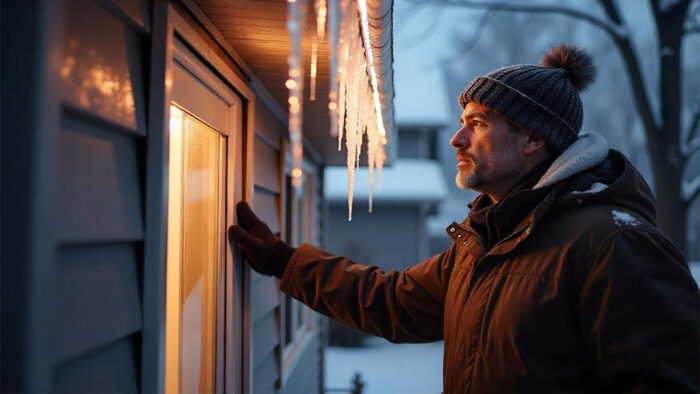Winter offers its own share of beauty and difficulties. Homeowners often face the issue of ice dams. These are thick ridges of ice that form at the margins of roofs. They can cause serious water damage in the house. In a situation like this, it is important for property owners to know if their homeowners insurance will cover damage caused by an ice dam, as the cost of repair can be pricey.

Many homeowners insurance policies cover water damage. However, the specifics and applicability of coverage can change. These changes depend on the policy’s term and the cause of the damage.
What Is an Ice Dam?
An ice dam is typically a ridge of ice that accumulates at the edge of a roof. It stops melting from draining off. This ultimately causes severe water damage to one’s property.
Water becomes trapped behind the dam when snow melts from the warmer part of the roof. This trapping can lead to leaks. It can also cause internal water damage. In winter, ice dams usually form in colder climates and are frequently made worse by insufficient attic ventilation or insulation.
Does Homeowners Insurance Cover Ice Dam Damage?
To an extent, a homeowners insurance policy should be able to cover damage caused by an ice dam. If an ice storm damages your roof, causing it to collapse, your homeowners insurance should cover the cost. It should pay for the repair or replacement of any part of your property that is damaged.
To be on the safer side, have an idea of what your policy covers. Check if it includes coverage for ice dams. This is because not all home insurance policies cover damage incurred from an ice dam. To be sure, check the content of your policy or reach out to your insurance company for enough clarity.
The coverage for damage caused by an ice dam largely depends on the specifics of your insurance policy. If you don’t have coverage for an ice dam, ask about additional coverage options. These can protect you from risk or damage caused by ice or melting snow.
What Causes Ice Damming?
Weather conditions are by far one of the major causes of ice damming. It can also be as a result of poor ventilation and insulation in your home. Inadequate insulation and ventilation make it worse, as they allow heat to escape and raise the temperature of the roof.
Furthermore, ice dams can form as a result of heavy snowfall, temperature fluctuations, and heat-trapping architectural features. This might eventually result in potential water damage as trapped water backs up under shingles and seeps into the house. Outlined below are typical signs that show you have ice damming:
- Peeling paint or wallpaper
- Lifted shingles
- Sagging roofline
- Wet insulation
- Waterlogged insulation
- Water stains on ceilings and walls
- Exterior sliding separation
- Mold or mildew growth
- Icicles forming on roof edges and around the gutters
- Decreased hit in upper levels of your home.
How to Prevent Ice Dams
Homeowners who care about their property’s appearance need to know how to prevent ice dams. This would ultimately help you to avoid certain damage that can pose a threat to your home and belongings. To help mitigate the risk of ice dams forming and causing damage to your home, consider the following tips:
- Clear your gutters regularly; ensure they are free of leaves and debris.
- Ensure your attic is well ventilated and insulated.
- Keep your roof in good condition.
- Install heating cables.
- Keep your roof clear of debris.
- Seal air leaks, if any.
- Check for and repair roof damage.
- Make sure you keep snow from accumulating on your roof.
Is it Worth Filing a Claim for an Ice Dam?
Deciding whether to file a claim for damage caused by an ice dam depends on the nature of the damage. It also depends on how severe the damage is. Be aware that, if you file a claim frequently, your insurance premium is likely to increase significantly. In some cases, it may be difficult to get coverage later on.
If the cost of damage incurred by the ice dam is minor, it is advisable to pay it out of pocket. Doing this is better than filing a claim with your insurer and getting charged higher premiums.
If the level of damage is severe, reach out to your insurer. File a claim if the cost of repairing your roof is expensive. Your insurance provider should be able to reimburse you for the cost of repair up to the limits of your policy.
The decision to file a claim for an ice dam depends on the severity of the damage it caused to your home. If it is minor damage, you may refrain from filing a claim. If it is not minor, reach out to your insurer to ease the financial burden.
FAQs
How do I know if I have an ice dam?
A good indicator of ice damming is icicles formed around the edges of your roof. If you also noticed that melted snow is not draining off properly, it is also a sign.
Be on the lookout for moisture or water stains on your interior walls and ceilings. These may indicate that water is backing up because of a blockage. Lastly, moist insulation in the attic or drooping portions of your roof could possibly indicate the formation of an ice dam.
How do I prevent ice damming?
It is possible to prevent ice damming by making sure your home is in good condition. Check the temperature of your home and ensure it is properly insulated and ventilated to avoid ice damming.
Can I file a claim for ice damage on my homeowners insurance?
Most definitely! You can file a claim with your insurance company for damage caused by ice damming. You will be required to provide documentation of the extent of damage incurred, take photos or videos, and if you also have receipts of the repair cost, show it to your insurer.



